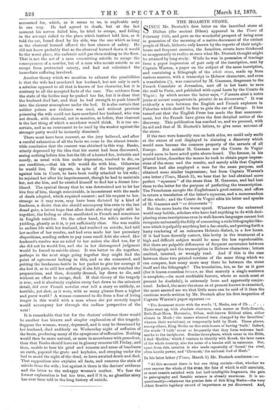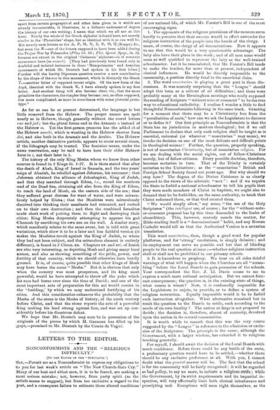THE MOABITE STONE.
SINCE Mr. Deutsch's first letter on the inscribed stone at Dhiban (the ancient Dibon) appeared in the Times of February 10th, and gave us the wonderful prospect of being soon in possession of the meaning of a native document of the extinct people of Moab, hitherto only known by the reports of their neigh- bours and frequent enemies, the Israelites, events have thickened so as apparently to realize at once what Mr. Deutsch thought might be attained by long study. While he was in possession of tracings from a paper impression of part only of the inscription, sent by Captain Warren, a paper on the subject of the same inscription, and containing a lithograph of the whole stone, made up from various sources, with a transcript in Hebrew characters, and even a translation (!), was concocted by M. Ganneau, dragoman to the French Consulate at Jerusalem, sent off in hot haste to save the mail to Paris, and published with equal haste by the Comte de Vogiid ; by which means the latter says, " J'assure ainsi h notre
jeune et savant compatriote la priorito de sa ddcouverte." It was evidently a race between the English and French explorers in Palestine which should be first to gain the ear of Europe. It has turned out that the English Press has made the first announce- ment, but the French have given the first detailed notice of the discovery. This publication has reached us, and we proceed, with its aid and that of M. Deutsch's letters, to give some account of the stone.
If the race were honestly run on both sides, we could only smile at the excess of zeal displayed in claiming a discovery which would soon become the common property of the savants of all Europe. But neither M. Ganneau nor the Comte de Vogiid would seem to have acted quite above-board. The former, in his printed letter, describes the means he took to obtain paper impres- sions of the stone and the results, and merely adds that Captain Warren had also employed a man for the same purpose, and obtained some similar impressions; but from Captain Warren's own letter (Times, March 3), we hear that he had obtained more perfect " squeezes " of the stone than M. Ganneau, and had lent them to the latter for the purpose of perfecting the transcription. The Frenchman accepts the Englishman's good-nature, and offers in return a translation of the latter's squeezes, and a memorandum of the whole ; and the Comte de Vogiie edits his letter and speaks of M. Ganneau and " an decouverte "!
But the more haste the worse speed. Whatever the unlearned world may babble, scholars who have had anything to do with deci- phering stone inscriptions even in well-known languages cannot but recognize universally the folly of concocting a rude lithographic like- ness which is palpably anything but a fac-simile, and putting forth a hasty rendering of an unknown Hebraic dialect, in a few hours. If it had been decently correct, this levity in the treatment of a high and difficult subject would be none the less reprehensible. But there are palpable differences of frequent occurrence between the lithograph and the transcription in Hebrew characters ; letters omitted, inserted, or wrongly read. And if this is the case between these two printed versions of the same thing which we can compare, how many more may there be between the stone itself and the lithograph? The translation, too, so far as it goes (for it leaves countless lacanx, so that scarcely a single sentence is complete,—its most creditable feature, where so much must at present be doubtful), is extremely loose and apparently conjec- tural. Indeed, the more the stone as at present known is examined, the more assured are we that little more can be said of it than the cautious words written by Mr. Deutsch after his first inspection of Captain Warren's paper squeezes :— 44 The document starts with the words, 'I, Mesha, son of Ch . . .
There start up, with absolute clearness, such names as Beth-Bamoth, Beth-Baal-Meon, Horonaim, Dibon, well-khown Biblical cities, either situate in Moab (' the names whereof were changed by the Israelites,' whence their variations), or temporarily held by Moab. These places, among others, King Mesha on this stele boasts of having 'built.' Indeed, the words ' I built' occur so frequently that they form welcome land- marks to the decipherer. Besides these places, which occur in the Bible, I find 'Karkha,' which I venture to identify with Kerek, the later name of the whole country, also the name of a hamlet still inexistence. Bat, apart from this, mention is also made repeatedly of 'Israel,' the rival, often hostile power, and Chemosh,' the national God of Moab."
In his later letter (Times, March 3) Mr. Deutsch continues :— " At this moment there is but one thing certain—that, whether we ever recover the whole of the atone, the fats of which is still uncertain, or must remain satisfied with but half-intelligible fragments, the gain to palaeography and Semitic science is already enormous. It is un- questionably—whatever the precise date of this King Mesha—the very oldest Semitic lapidary record of importance as yet discovered. And,
apart from certain geographical and other data given in it which are already incontestable, it illustrates, to a hitherto undreamt-of degree the history of our own writing ; I mean that which we all use at this hour. Nearly the whole of the Greek alphabet is found here, not merely similar to the Phcenician' shape, but as identical with it as can well be.
Not merely such letters as the A, P, M, N, E, 0, Q (Koppa),
but even the '—one of the letters supposed to have been added during the Trojan War by Palamedes (Pliny vii. 56 ; Plot. Quest. Symp., ix. 3), because not extant in the original Cadmean ' alphabet—is of constant occurrence here (as samech). [They had previously been found only in doubtful and isolated instances in those Mesopotamian' and Assyrian monuments of which Mr. Deutsch had spoken in his first letter.] further will the knotty Digamma question receive a new contribution by the shape of the vav in this monument, which is distinctly the Greek T,—another letter of supposed recent origin. Of the new form of the haph, identical with the Greek K, I have already spoken in my first aetter. And another thing will also become clear, viz., that the more primitive the characters, the simpler they become ; not, as often supposed, the more complicated, as more in accordance with some pictorial proto- type."
As far as can be at present determined, the language is but little removed from the Hebrew. The proper names are spelt nearly as in Hebrew, though generally without the vowel letters slay and fed; but the plural forms end in the Aramaic n instead of the Hebrew m. Yet the first-person pronoun has the added ch of the Hebrew anochi, which is wanting in the Hebrew shorter form ani, and also both in the Aramaic and the Arabic. The Hebrew article, another distinctive particle, appears to occur several times, sif the lithograph may be trusted. The feminine nouns, under the same reservation, may be said to have here their older Hebrew form in t, not their later in h.
The history of the only King Mesha whom we know from other sources is found in 2 Kings iii. 4-27. It is there stated that after the death of Ahab, King of Israel in Samaria, and the two years' ;reign of Ahaziah, he rebelled against Jehoram, his successor ; that .Jehoram obtained the alliance of Jehoshaphat, King of Judah, and that they marched through Edom, i.e., round the southern snd of the Dead Sea, obtaining aid also from the King of Edom, to reach the land of Moab, on the eastern side of the sea ; that they suffered great distress for, want of water, and were miracu- lously helped by Mahe.; that the Moabites were miraculously deceived into thinking their assailants had retreated, and rushed .on to their own destruction ; and then the combined Israelites suede short work of putting them to flight and destroying their -cities; King Mesha desperately attempting to appease his god Chemosh by sacrificing his own son on the wall. A similar story, which manifestly relates to the same event, but is told with great variations, which show it to be a later and less faithful version (it makes the Moabites revolt against the King of Judah, to whom they had not been subject, and the miraculous element is entirely different), is found in 2 Chron. xx. Chapters xv. and xv:. of Isaiah are also very interesting, as depicting Moab and giving many local mimes, and also as showing something of the pride, power, and fertility of that country, which we should otherwise have hardly guessed. It is, of course, quite possible that other kings of Moab may have borne the name "Mesha." But it is obvious that only when the country was most prosperous, and its king moat powerful, would he have attempted to throw off the yoke which his race had borne ever since the time of David ; and one of the most important acts of preparation for this act would consist in the building,' by which we may understand fortifying of his -cities. And this consideration enhances the probability that the Mesha of the stone is the Mesha of history, of the ninth century before Christ, and that the atone reports the acts of a powerful 'king making his land strong against foes, and was set up con- siderably before his disastrous defeat.
We hope that Mr. Deutsch may soon be in possession of the -originals of the pieces by which M. Ganneau has filled up his saps,—promised to Mr. Deutsch by the Comte de Vogii6.



































 Previous page
Previous page